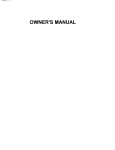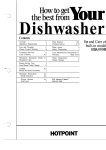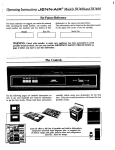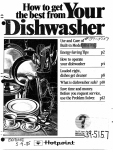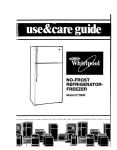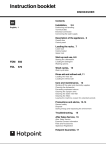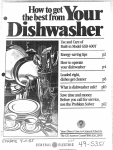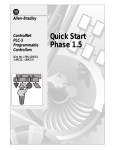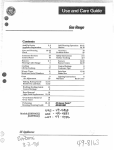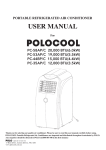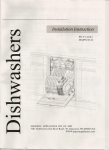Download Jenn-Air DU430 Dishwasher User Manual
Transcript
0 E N N-AI
Operating Instructions
R ®Model DU430
For Future Reference
For future reference we suggest you retain this manual
after recording the model number and serial number
(six numbers and two letters) of this dishwasher in the
spaces provided below. This information can be found
on the data plate located on the upper left corner of the
tub opening.
Model No.
Be sure to provide the model number of your appliance.
Consumer Relations Department
Jenn-Air Company
3035 Shadeland
Indianapolis, IN 46226-0901
Serial No.
i
Should you have any questions about using your
Jenn-Air dishwasher, write us.
appliance has been grounded to avoid possible elecWARNING: Check with installer to make sure
trical shock. Be sure you read the IMPORTANT
SAFETY PRECAUTIONS on page 2 before you start
to use this dishwasher.
The Controls
On the following pages are detailed instructions on
how to use your beautiful new Jenn-Air dishwasher
to get the best results. Please read these instructions
carefully before using your dishwasher for the first
time. Using the correct procedures will insure the best
possible results.
|
1
Jenn-Air offers a full line of dishwashers, compactors
and food waste disposers plus...a complete line of electric and gas
cooktops, ranges and grills, built-in ovens and refrigerators.
Jenn-Air...finest by design.
IMPORTANT
_WARNING
Products with
a UL label have been listed with
the Underwriter's Laboratories.
Inc.--those with a CSA tag
have been listed with Canadian
Standards Association.
Nevertheless, as with any other
equipment using electricity and
moving parts, there is a
potential hazard. When using
your dishwasher, follow basic
precautions, including the
following:
1. Read all instructions before
using the dishwasher,
2. Use the dishwasher only for
its intended function,
3. To avoid electrical shock
hazard, the sides and back
must be enclosed, and the
front panels must be attached
before electrical power is
applied to the dishwasher.
Refer to the installation
instructions for proper
grounding procedures,
4. Children should never be
permitted to operate, or play
in, with or around this ....
dishwasher,
5. To reduce the risk of injury
when loading items to be
washed, sharp or pointed
items should be located with
the handles up. Also, load
sharp items so they are not
....
likely to damage the door seal.
6. Be careful not to touch the
heating element on the bottom
of the tub during or at the
completion
of a cycle. It may
be hot.
7. Do not store or use
combustible materials,
gasoline or other flammable
vapors and liquids in the
vicinity of this or any other
appliance.
8. Use only a detergent
designed for an automatic
dishwasher. Never use soap,
laundry detergent, or hand
washing detergent in your
dishwasher. Keep these
products out of the reach of
children.
9. Do not sit, stand on or abuse
the door or dish rack of the
dishwasher,
10. To minimize the possibility
of electric shock, disconnect
this appliance from the power
supply before attempting any
maintenance. Note: Turning
the control dial to the OFF
position does not disconnect
the appliance from the power
supply. We recommend
having a qualified technician
service your appliance.
11. A WARNING---Under
certain conditions, hydrogen
gas may be produced in a hot
water system that has not
been used for two weeks or
more. Hydrogen gas is
explosive. If the hot water
system has not been used for
two weeks or you have
moved into a residence in
which the hot water system
may not have been used for
some time. turn on all hot
water faucets and let the
water flow from each for
several minutes. This will
release any accumulated
hydrogen gas. As the gas is
flammable, do not smoke or
use an open flame during this
process.
12. Do not wash plastic items
unless marked "dishwasher
safe" or the equivalent. For
plastic items not so marked,
check the manufacturer's
recommendations.
13. Load light plastic items so
they will not become
dislodged and drop to the
bottom of the
dishwasher--they may come
into contact with the heating
unit and be damaged.
14. Do not tamper with controls.
15. Always remove the door to
the
washing
compartment
when
removing
an old
dishwasher from service or
discarding it.
16. Instructions for grounding
this appliance can be found in
the Installation Instructions.
SAVE THESE
INSTRUCTIONS
How to operate your dishwasher
Door Latch
Cycle Indicator Dial
(Turn to Start)
Vapor Vent
HHHk HHHHI;
t-
1
MVV
O.vl_6
STEP 1. Load your dishwasher
with dishes, silverware, pots,
pans, bowls, etc. according to
instructions on pages 7 and 8.
STEP 4. Select the cycle and start
the dishwasher. See Cycle Selection
Hints on the next page.
If your dishwasher drains into a
U
• For CONSERVA WASH cycle:
a. Be sure door is unlatched.
b. Push NORMAL WASH button.
Atrgntote
°°dwate
°peraete
].0w
detergent
dispenser.
sure the
Cycle Indicator
Dial Make
is at OFF
position before adding detergent.
(See pages 5 and 6.)
Use rinse aid agent to help prevent
spotting. Occasionally check to
make sure the rinse agent dispenser
disposer the
until
it is empty before
starting
dishwasher.
• For HEAVY WASH and
NORMAL WASH cycles:
_=1
F:=_
°"Y
b. Latch the door.
a. Push selected cycle button,
b.CONSERVA
Select AIR DRY option.
AI°
DRY
WASH
Use of this option reduces the
electrical energy used by this
model approximately 7 % for the
NORMAL WASH cycle,
•
ON
CONSERVA
the drying heater off to save energy.
Dishes will dry naturally over a
longer period such as overnight,
If you need your dishes sooner,
open the dishwasher door after the
cycle is complete to reduce the
natural drying time.
RINSE
&HOLD
d. Latch door to start the cycle.
• For RINSE & HOLD cycle:
a. Be sure door is unlatched.
HEATED
HEATED DRY. Turns the drying
heater on for fast drying.
AIR DRY (no-heat drying). Turns
)_
D.Y,.G
C. Slowly turn Cycle Indicator Dial
to CONSERVA WASH position.
HEAVY ,0,MAt
WAS. WASH
is
at least
half full.
(See Option.
page 5.)
STEP
3. Select
Drying
WAS, ===
ON
OFF
wAS. :
OFF •
OFF
ON
RINSE
&HOLD
,
D,Y_,G
c. Slowly turn Cycle Indicator Dial
to ON position to start the cycle,
You will hear the motor start.
There is a time delay between
start-up and water fill so you
will not hear any wash action
right away.
To obtain the benefits of a complete
cycle, be careful that you do not
turn the dial any further than
necessary to start the dishwasher.
•
•
•
&HOLD
RIMS[
DRYING
C. Slowly turn Cycle Indicator Dial
to RINSE&HOLD position.
d. Latch the door to start the cycle.
Cycle selection hints
It is important to follow the loading
instructions on pages 7 and 8.
HEAVY WASH--For items such
as pots, pans and casseroles with
dried-on or baked-on soils.
Everyday dishes may be included.
NORMAL WASH--For loads
of everyday dishes, glasses
and cookware.
CONSERVA WASH--For dishes
that are lightly soiled with soils that
have not dried on. Also for everyday
dishes that have extra preparation
before loading.
RINSE&HOLD--For rinsing
partial loads which will be washed
later. Do not use detergent.
What happens in each cycle
* You'll hear occasional clicking
sounds:
* During the drying period:
--The motor stops.
--Soft food disposer shredding
action,
--Drain valve opening to pump
water out.
--Timer control as cycle
progresses.
--Water vapor comes through the
vent by the door latch during
drying and when water is being
pumped out.
--Detergent cup opening.
Wash
Cycles
Wash
Water Use Cycle Time
Gallons
Minutes
(approx.)
(approx.)
Cycle Sequence
HEAVY WASH
12.1
65*
_
Ri______]
NORMAL WASH
12.1
50*
_
_
_
CONSERVA WASH
10.3
44*
_
RI_____
RINSE&HOLD
4.9
14
IMaa_ I_
_
___
*Unextended times. These cycle times may be increased up to 7 J/2minutes if necessary for your
dishwasher to heat the water to proper temperature for good washability.
Drying Options:
HEATED DRY. Available on all wash cycles except RINSE & HOLD. Add 25 minutes to wash
cycle time.
AIR DRY. Drying heater is turned off. Dishes dry naturally.
_
Water Temperature
Control System
Help prevent spotting
with a rinse agent,
How to choose and use
the right detergent.
To get dishes clean and dry you
need hot water. To help you get
water of the proper temperature,
your dishwasher has a water heating
A rinse agent makes water flow
off dishes quicker than usual. This
lessens water spotting. Makes
drying faster, too.
First, use only powder or liquid
detergents specifically made for
use in dishwashers. Other types
will cause oversudsing.
feature that automatically senses
the
temperature
of the
in the
wash
cycle and heats
it, water
if necessary,
to the proper temperature. This
water heating feature may allow
you to turn down your household
For best dishwashing performance,
use of a rinse agent is recommended,
Rinse agents come in either liquid
or solid form. Your dishwasher's
dispenser uses the liquid form.
water heater and save energy if
you're willing to let the dishwasher
run a little longer while it heats
water to the proper temperature,
For good washing and drying, the
entering water must be at least
120°F. To prevent dish damage,
inlet water should not exceed 150°E
Here's how to fill the rinse agent
dispenser. Unscrew the cap. Add
the liquid rinse agent until it just
reaches the bottom of the lip inside
the dispenser opening. Replace the
cap. The dispenser automatically
releases the rinse agent into the
final rinse water,
Second, check the phosphate
content. Phosphate helps prevent
hard-water materials from forming
spots or film on your dishes. If
your water is hard (7 grains or
more), your detergent has to work
harder. Detergents with a higher
phosphate level will probably work
better. If the phosphate content is
low (8.7% or less), you'll have to
use extra detergent with hard water.
How to test water temperature:
Check your water temperature with
a candy or meat thermometer. Turn
on the hot water faucet nearest the
dishwasher. Put the thermometer
in a glass and let the water run
continuously into the glass until the
temperature stops rising. If the
water temperature is below 120°E,
adjust your water heater,
If you accidentally spill: Wipe
up the rinse agent with a damp
cloth. Don't leave the spill in the
dishwasher. It can keep your
detergent from working.
Helpful hints: If outside
temperatures are unusually low, or
if your water travels a long distance
from heater to dishwasher, you may
need to set your heater's thermostat
up. If you have not used hot water
for some time, the water in the
pipes will be cold. Turn on the hot
water faucet at the sink and allow it
to run until the water is hot. Then
start the dishwasher. If you've
recently done laundry or run hot
water for showers, give your water
heater time to recover before
operating the dishwasher,
_
Your dishwasher's rinse agent
dispenser holds 4 V, ounces. This
should last about 3 months. Fill
as needed. Do not overfill.
Your water department can tell
you how hard your water is. So
can your Extension Agent. Or your
area's water softener company. Just
call and ask them how many "grains
of hardness" there are in your water.
How much detergent should you
use? That depends. Is your water
"hard" or "soft"? With hard water,
you need extra detergent to get
dishes clean. With soft water, you
need less detergent.
Too much detergent with soft water
not only wastes money, it can be
harmful. It can cause a permanent
cloudiness of glassware, called
"etching." An outside layer of glass
is etched away! But why take a
chance when it's easy to find out
the hardness of your water.
Keep your detergent fresh and
dry. Under the sink is not a good
place to store detergent. Too much
moisture. Don't put powder detergent
into the dispenser until you're
ready to wash dishes, either. (It
Won't be fresh OR dry.)
If your powder detergent gets old
or lumpy, throw it away. It won't
wash well. Old detergent loses its
power. Lumpy detergent often
won't dissolve.
If you use a liquid dishwasher
detergent, these precautions are not
necessary because liquid detergents
don't "lump" as they age or come
in contact with water.
How to prepare the
dishes for washing.
You'll find two detergent
dispensers on the inside door of
your dishwasher. There are two,
because some cycles use two washes,
/_#
OPEN
CUP _\_\
_k:-- _
_
J
\
\
_NCUP
_-
_
See "Detergent Usage Guide" below,
(Be sure the Cycle Indicator Dial
is at OFF position before adding
detergent. Otherwise, the detergent
cup lid will not close and latch
properly.)
GRASP HANDLE,
ROTATE
J_
_
TA__
1
Always close the main cup tightly
When firmly latched you will hear a
clicking sound. Do not overtighten,
NOTE: Detergent cup may be
opened manually with no harm.
Turn handle counterclockwise until
it releases. A snapping sound is
normal when it opens.
If this is your first dishwasher, or
if you're replacing a much older
model, you may wonder how much
pre-preparation your dishes need.
Actually very little. Pre-rinsing of
Note: The foods mentioned here
are for examples only. Other foods
not mentioned may also need to be
removed from your dishes. You
may also want to consider removing
With
sense
andnecessary,
a what
little
practice
you'llsoils
soon
normalcommon
food
is know
not
foods to remove. Here are some
vinegar,
lemon
juice discoloration
andmayonnaise,
other
foods
that
can
cause
such
as mustard,
of stainless steel if allowed to
guidelines:
toothpicks and other hard solids. It
is also best to remove hard shelled
1. Scrape offbones,
seeds, skins,
vegetables,
meat trimmings,
leafy
remain
on dishes
for a longWASH
period
When using
the HEAVY
cycle, less preparation is required
of
time.loading. The HEAVY WASH
before
vegetables and crusts. Remove
excessive quantities of oil or
grease,
2. Remove large quantities of any
food. Your dishwasher has a built-in
soft food disposer that pulverizes
cycle can wash heavily-soiled
dishes and remove dried-on and
baked-on soils from pots, pans and
casseroles. Items with burned-on
soils may not come clean. And the
dishwasher
cannotfading
remove
burnby
marks or restore
caused
soft food bits and flushes them away.
It can handle small amounts of
overheating during cooking.
soft foods,
large amounts
of or
food
as softbut
as mashed
potatoes
applesauce will be difficult to handle.
3. Try to remove food scraps and
place dishes in dishwasher before
soil has a chance to dry and become
hard. Dishes with dried-on soil are
more difficult to wash and may
not come clean in the NORMAL
WASH cycle. Remember to use
your RINSE & HOLD cycle for
small "holding" loads.
Detergent Usage Guide (powder or liquid)
CYCLES
HEAVY WASH and
NORMAL WASH cycles
CONSERVA WASH cycle
RINSE & HOLD cycle
SOFT WATER
(0-3 grains hardness)
Main Cup:[:
Open Cups
MEDIUM WATER
(3-7 grains)
Main Cup{
Open Cup-
HARD WATER
(7-12 grains*)
Main Cup-_
1 Tablespoon
minimum
1 Tablespoon
minimum
Half Full
Completely
Full
Completely
Full
1 Tablespoon
minimum
None
Use no detergent
_ Half Full
Half Full
None
Use no detergent
"12grains and up is extremely hard water. A water softener is recommended. Without it,
lime can build up in water valve. Water valve may stick while open and cause flooding.
Open Cups
-I Completely
Full
None
Use no detergent
:Filled Main Cup holds 3 tablespoons;
Filled Open Cup holds 2 tablespoons.
How to load your dishwasher
How to load the TOP RACK
This is a random mixed load, the most common type you
will have.
The top rack is best for glasses, cups and saucers. Cups
and glasses fit best along the sides. This is the place for
dishwasher-safe plastics, too. Make sure small plastic
items are lodged in tightly so they can't fall onto the
heating unit. Arrange stemware so that it cannot move
easily. Don't let the glasses touch each other.
Make sure dishes are properly loaded to insure that
water can reach the soiled surfaces. The wash arm in
the bottom sprays water up. The tower that rises in the
center sends water out over the dishes to wash the items
in the upper rack. A spray arm in the top washes down
also. Make sure to place tall items to the outside so the
upper wash arm is not blocked.
Sauce pans, mixing bowls and other small items may
be placed--face down--in the top rack. The top rack is
handy for all kinds of odd shapes. Be sure the force of
water and detergent can reach soiled surfaces.
WATCH OUT FOR THIS.
The wash tower rises through the center of the bottom
rack during the wash and rinse portions of the cycle.
Don't block it or load tall things next to it. Also, be
careful not to let a portion of an item such as a pot or
dish handle extend through the bottom rack. This could
block the wash arm and cause poor washing results.
7
How to load the BOTTOM RACK
i
Fit plates and saucers between the pins. Place items so
that water and detergent from wash arm can reach soiled
surfaces,
Heavily soiled pots, pans and casseroles MUST be
loaded in the bottom rack, facing down. Prop broiler
pans and racks along the edge.
Put flatware in the removable basket with handles up
to protect your hands. Mix knives, forks and spoons so
they don't nest together. Distribute evenly. Small plastic
items, such as measuring spoons and lids from small
containers are not recommended for automatic
dishwashing. If placed in dishwasher, they should go
in bottom of silverware basket with silverware on top.
PRECAUTION. t
Take out anything that may fall or extend through the
bottom of the basket.
What you can usually wash safely in your dishwasher.
And what you can't.
Material
Usually
Safe
Aluminum
YES
Some colored anodized
aluminum can fade.
Some darkening or spotting possible. Remove by
scouring with soap-filledsteel wool pads.
China/
Stoneware
YES
Antique, metal-trimmed,
hand-painted or over-the-glaze
patterns fade.
Gold leaf will discolor.
If in doubt, check with the manufacturer. Or test wash
one piece daily for at least a month. Compare with the
rest of the set.
Crystal
YES
Antique, metal-trimmed or
hand-painted patterns fade.
Gold leaf will discolor.
Load securely to prevent movement.
Check manufacturer's instructions for your crystal.
Exceptions
(not safe)
Special Instructions
Do not wash in dishwasher. Damage to dishwasher
and discoloration or staining of dishwasher may result.
filters, furnace
filters, paint
brushes, etc.
Glass
YES
Milk Glass mayyellow.
Iron
NO
Ironwill rust.
Pewter
NO
Pewtertarnishes.
Plastics
YES
Ifit" doesnt' say DISHWASHERSAFE, testone piece
before dishwashing an entire set. Wash in top rack only.
Stainless steel
YES
Rinse if notwashingimmediately. Salty or acid foods
can stain if left on.
Sterling Silver
and Silver
plate
YES
Don't put in same silverware
basket with stainless steel,
Contact betweenmetals can
damage silver,
Don't wash copper utensils in
the same load. Silver may get a
brown film.
Rinse if not washing immediately. Salty or acid foods
can stain if left on. Dry detergentcan cause difficultto-remove black spots. Place in back section of silverware
basket to avoidexposure to detergentfrom the detergent cup.
Adhesive used to attach some
Non-stick
coatings
Wood
YES
After washing, wipe the non-stick coating area with
vegetable oil to keep it from losing its non-stick quality.
NO
Tin can rust.
NO
Wood can warp, crack or lose
its finish with any type washing.
Forget a dish? Here's when
you can add it.
However, opening the door during
any cycle lessens cleaning power,
Add dishes any time during the
So try to load everything
RINSE & HOLD cycle. With other
wash cycles, you can add dishes
at any time BEFORE the main
detergent wash portion of the cycle.
beginning.
Here's how to add a forgotten dish:
1. Push the door latch to the left.
Washing will stop.
9
at the
2. Wait a few seconds until the
water calms. Then open the door.
3. Add dishes you've forgotten.
4. Close the door and push the
latch to the far right. When the
door is locked, washing will
continue.
Questions?
Use This Problem Solver
PROBLEM
POSSIBLE CAUSE AND REMEDY
10
PROBLEM
POSSIBLE CAUSE AND REMEDY
(continued
11
nextpage)_
The Problem Solver
PROBLEM
(continued)
POSSIBLE CAUSE AND REMEDY
Water around the outlet on the tub bottom at the back of the tub is normal. It is clean
water. It s there to keep the water seal lubricated.
IN THE BOTTOM
OF THE TUB
I
I
I
I
Check the kitchen sink. Is it draining well? You may need a plumber.
To remove suds from the tub: Open the dishwasher. Let suds evaporate. Add 1 gallon
of cold water to the tub. Close and latch the dishwasher. Pump out water by slowly
turning the control dial until a drain period is reached.
Repeat if necessary.
Suds can cause unit to overflow. That's why it's so important to use a detergent that's
designed for automatic dishwashers.
Spilling the rinse agent can cause foam during washing. This can lead to overflowing.
Wipe up accidental spill of rinse agent with a damp cloth.
/2
How to change color panels
If you are redecorating, you can
change your dishwasher's front
panel to match or blend with your
new colors,
Note: Other color panels are
available for your dishwasher.
Check the color you want on the
order form below and mail it to us.
The panel is held in place by the
door trim and the trim on the
panel below the door. Each side
of each panel is a different color
or you can paint a panel with the
color of your own choice,
Wood panel trim kit GPF 40
contains trim and instructions for
adding a decorative wood door
panel and lower access panel to
match kitchen cabinets. Use the
order form below to order this kit.
_J
,JT-::::::::::::::::::
f
-
ORDER FORM
How to change the door panel:
1. Takeout three trim screws on
Use this form to order, without charge, your choice of a
color panel not supplied with your dishwasher or a wood
either
side
the trim.
dishwasher door.
Remove
theofside
2. Slide the door panel out.
(Careful--edges may be sharp.)
3. Turn the door panel around and
put the color you want in front.
4. Replace the door panel, side
trim and screws.
How to change the lower panel:
panel trim kit.
Please mark only one box.
D
White/Almond
[]
Door and Access Panel GPF 24
Harvest/Black
Door and Access Panel GPF 26
_=
LH
Q="'
L_
2=
1. Remove four panel attachment
screws. (Two above the panel, two
below the panel.)
"r-
5
o
F]
2. Remove the entire panel.
3. Take out three screws and
remove the top trim.
Kit GPF 40
WoodPanelTrimKit
FOLDHERE
4. Slide the lower panel out.
5. Turn the panel around and put
the color you want in front.
Name:
6. Replace the lower panel, top
trim and screws.
Address:
7. Replace the entire panel and
four attachment screws.
City:
Do not operate the dishwasher
while changing panel or when
lower access panel is removed.
State:
Model No.:
Date Purchased:
13
Zip Code:
Serial No.-
S
o
Care and Cleaning
USER MAINTENANCE
INSTRUCTIONS
Clean the control panel with
Built-in di,_hwashers
often use an air gap.
Keep it clean,
Not using your dishwasher
in winter? Protect against
freezing.
a lightly dampened cloth. Dry
thoroughly. Do not use abrasives
or sharp objects on the panel,
They can damage it.
Clean the outside with a lightly
dampened cloth. The outside
cabinet finish is durable, but it can
An air gap is a plumbing device.
It protects your dishwasher against
water backing up into it if a drain
clogs. The air gap is not a part of
the dishwasher. And you may not
even have one. Not all plumbing
codes require air gaps.
If your dishwasher is left in an
unheated place during the winter,
ask a service technician to:
or
harsh Do
or gritty
cleaners.
scratch.
not use
scouring pads,
The inside usually takes care
of itself. If it should ever need
__
cleaning, use a mild cleansing
powder. Scouring pads and harsh
__
____=
cleaners can mar the finish.
_J_
Jllll[[I
Two
TYPES
OFAIRGAPS
,rr :_
I_
_iJ_-_
_==_'
• Cut off electric power to the
dishwasher. Remove fuses or trip
circuit breaker.
Turn off the the
water
supply.
*• Disconnect
water
inlet line
from the water valve.
• Drain water from the inlet line
and water valve. (Use a pan to
_
_
__
If you have an air gap, check it
at least once a month. IT IS NOT
PART OF YOUR DISHWASHER.
IT IS NOT COVERED IN YOUR
WARRANTY.
The air gap is easy to clean.
With most types, first turn off the
dishwasher, then lift off the chrome
cover. Then unscrew the plastic cap
and check for any buildup of grit.
A toothpick makes cleaning easy.
Check the air gap any time your
dishwasher isn't draining well.
15
• Reconnect the water inlet line to
the water valve.
catch
the water.)
• Remove
the plastic pump cover in
the tub bottom and use a sponge to
soak up water in the rubber boot.
POMPCOVERSCREWS
_'.:'_!..














